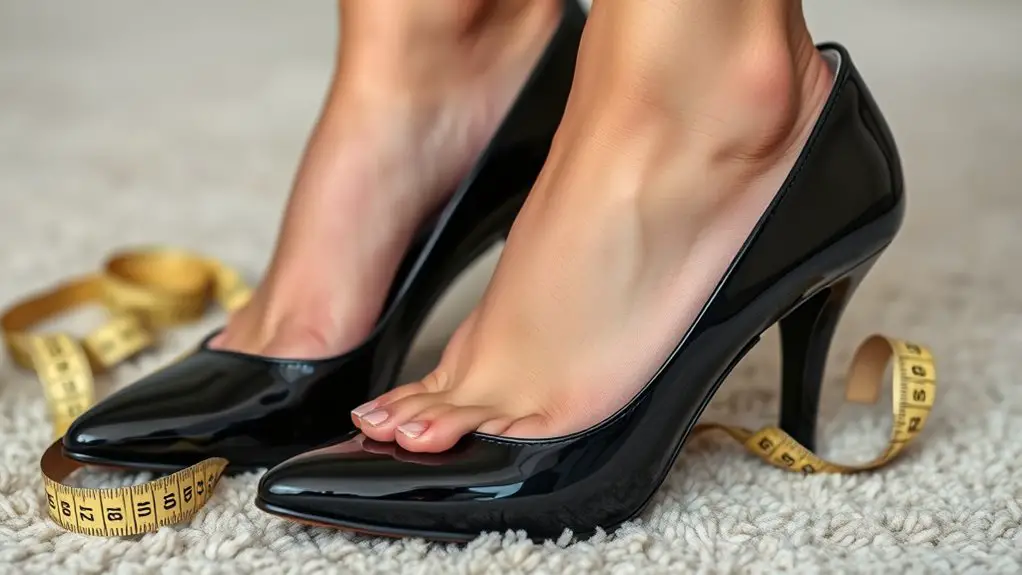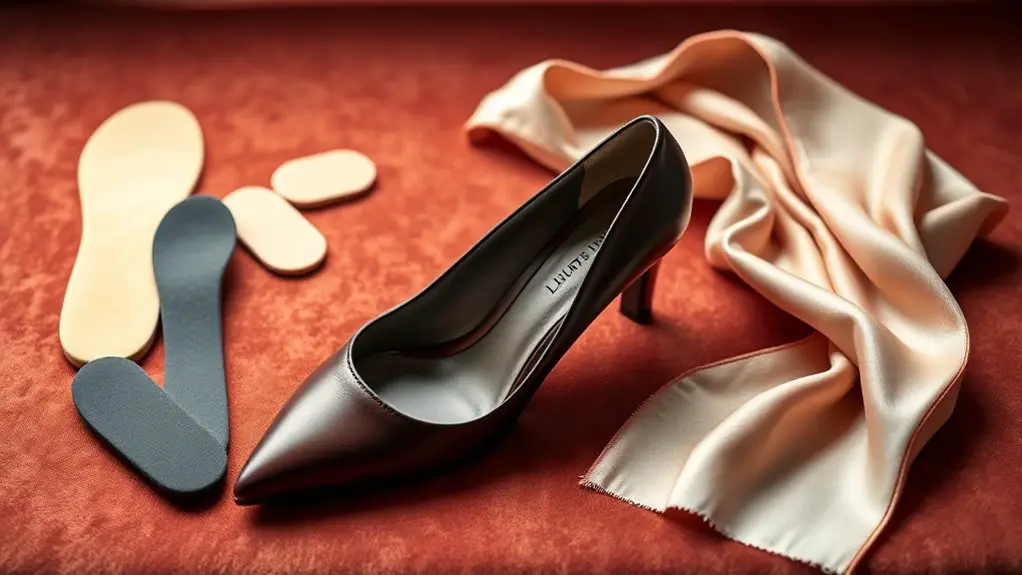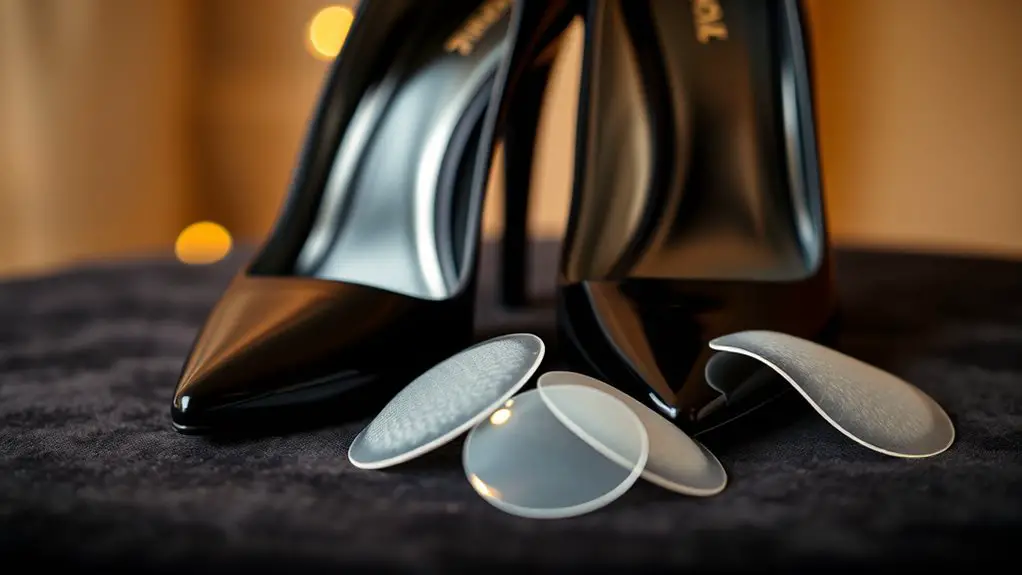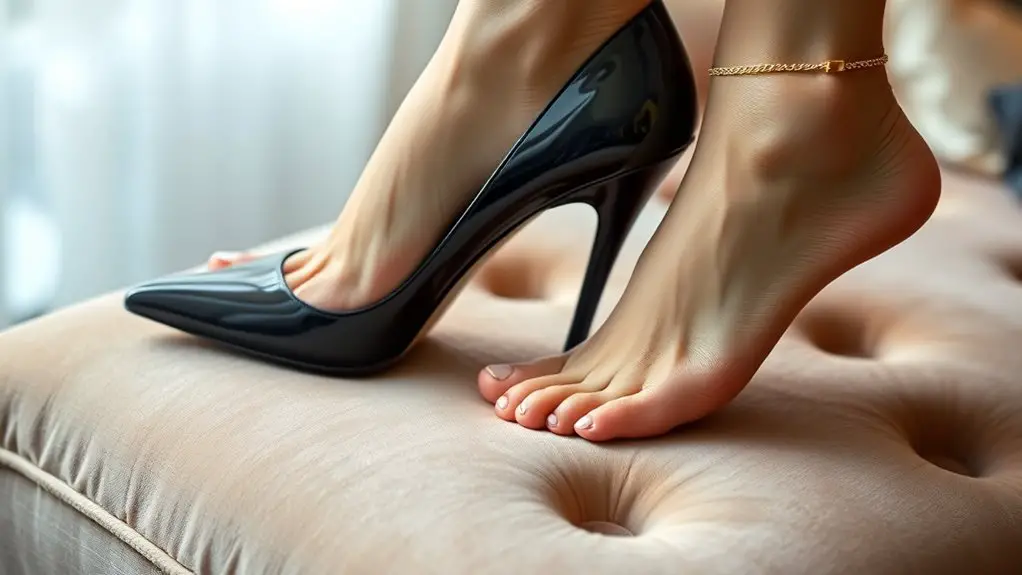To make 5-inch heels more comfortable, start by choosing the right size and fit; your shoes shouldn’t pinch or cramp your toes. Opt for cushioned insoles to enhance comfort and invest in quality craftsmanship for better support. Break them in gradually to avoid pressure points. Consider using heel grips and pads for extra cushioning. Maintain proper posture while walking, and take breaks to stretch your feet. There are more tips to explore that can enhance your comfort even further.
Choose the Right Size and Fit

When it comes to making heels more comfortable, choosing the right size and fit is essential. You’ve gotta pay attention to shoe sizing, as an ill-fitting pair can lead to discomfort and pain. Start by measuring your feet regularly, since they can change over time. When trying on heels, make sure there’s a snug fit without pinching; your toes shouldn’t feel cramped.
Consider your foot shape, too. If you’ve got wider or narrower feet, look for brands that cater to your specific needs. Some styles might offer extra room or come in different widths, which can make a significant difference. Always walk around in the shoes to test their comfort level. Remember, a good fit should allow for some movement while still providing support. Prioritizing size and fit can greatly enhance your comfort when rocking those stylish heels.
Opt for Cushioned Insoles
Finding the right size and fit is just the beginning of your journey to comfortable heels. To truly enhance your experience, consider opting for cushioned insoles. These insoles provide the cushioned support your feet crave, allowing you to wear your heels longer without discomfort. Look for insoles specifically designed for high heels, as they often feature extra padding in key areas, promoting arch relief and reducing pressure on the balls of your feet.
When you slip these insoles into your favorite pair of 5-inch heels, you’ll notice an immediate difference in comfort. The added cushioning helps absorb shock, making each step feel softer. Plus, a good insole can improve the fit of your shoes, preventing slipping and blisters. Investing in cushioned insoles is a simple yet effective way to elevate your heel-wearing experience, allowing you to strut your stuff with confidence and ease.
Invest in Quality Shoes

Investing in quality shoes is essential for both comfort and style. When you choose the right fit and prioritize materials, you’ll notice a significant difference in how your heels feel throughout the day. Quality craftsmanship not only enhances comfort but also supports your feet, reducing the risk of pain and injury.
Choose the Right Fit
Choosing the right fit is essential for guaranteeing comfort in heels, and it often means investing in quality shoes. When shopping, pay attention to the toe box and arch support. A proper toe box allows your toes to wiggle without crowding, while good arch support helps distribute your weight evenly, reducing strain.
Here’s a quick guide to help you choose the right fit:
| Feature | Importance |
|---|---|
| Toe Box Size | Prevents pinching and discomfort |
| Arch Support | Reduces fatigue and pain |
| Heel Height | Affects balance and comfort |
| Width | Guarantees snug fit without squeezing |
| Material | Impacts flexibility and support |
Materials Matter Most
The right materials can make a world of difference in how comfortable your heels feel. Investing in quality shoes not only enhances your style but also contributes to your comfort. Pay attention to material types and shoe construction when selecting your next pair. Here are essential considerations:
- Leather: Offers durability and breathability, molding to your foot shape over time.
- Cushioned Insoles: Provide extra support and shock absorption, reducing pressure on your feet.
- Flexible Outsoles: Allow for natural foot movement, minimizing strain during wear.
Choosing the right materials can prevent discomfort and foot fatigue, allowing you to enjoy your heels longer. Don’t skimp on quality—your feet will thank you!
Break Them In Gradually
Although you might be enthusiastic to wear your new heels, breaking them in gradually is essential for long-lasting comfort. Start by wearing them around the house for short periods. This gradual wear allows the shoe flexibility to adjust to your feet without causing excessive discomfort. Aim for 30 minutes to an hour at first, and then increase the duration each time you wear them. Pay attention to any pressure points or areas that feel tight, as these can indicate spots that need more time to soften.
You can also try wearing thicker socks during these sessions to help stretch the material gently. Remember, the goal is to let your heels mold to your feet, enhancing comfort over time. By being patient and consistent with this process, you’ll make your stunning 5-inch heels more comfortable and ready for those special occasions.
Use Heel Grips and Pads

If you’re struggling with slipping heels or discomfort at the back of your foot, using heel grips and pads can be a game changer. These simple additions can greatly enhance your comfort level while wearing 5-inch heels. There are several heel grip types available, including silicone, foam, and fabric options. Each type offers unique benefits, so choose the one that suits your needs best.
Struggling with slipping heels? Heel grips and pads can transform your comfort in 5-inch heels.
When it comes to pad materials, look for gel or memory foam as they provide excellent cushioning and support.
Here are some benefits of using heel grips and pads:
- Prevent Slipping: Keeps your foot securely in place.
- Reduce Friction: Minimizes blisters and irritation.
- Enhance Comfort: Provides extra cushioning for long wear.
Maintain Proper Posture
To make your heels more comfortable, it’s crucial to maintain proper posture. Aligning your spine, engaging your core, and distributing your weight evenly can greatly reduce discomfort. By focusing on these elements, you’ll not only improve your comfort but also enhance your overall stability while wearing heels.
Align Your Spine
When you wear heels, aligning your spine is essential for comfort and stability. Proper spinal alignment and posture correction help distribute your weight evenly, reducing strain on your back and feet. Here are a few tips to maintain your alignment:
- Stand tall: Keep your shoulders back and your chest lifted.
- Engage your glutes: They play a vital role in stabilizing your pelvis and spine.
- Balance your weight: Shift slightly forward onto the balls of your feet, but avoid leaning too far.
Engage Your Core
Engaging your core is essential for maintaining proper posture while wearing heels. A strong core supports your spine, helping you stand tall and stable. To achieve this, incorporate core strengthening exercises into your routine, such as planks or bridges. These exercises enhance your abdominal and back muscles, providing the foundation needed for balance training.
When you wear 5-inch heels, your center of gravity shifts, making it vital to engage your core to prevent slouching or leaning forward. Focus on tightening your abdominal muscles as you walk, which not only improves your posture but also increases your overall stability. Practicing these techniques will make wearing heels more comfortable, allowing you to enjoy your style without compromising your well-being.
Distribute Weight Evenly
Maintaining proper posture goes hand in hand with distributing your weight evenly while wearing heels. Good weight distribution not only enhances shoe balance but also reduces strain on your feet and legs. Here’s how to achieve it:
- Stand tall with your shoulders back and chest forward.
- Shift your weight slightly to your heels and the balls of your feet, avoiding pressure on your toes.
- Keep your hips aligned with your knees to promote an even weight distribution.
Take Breaks and Stretch
Even if you love wearing heels, taking breaks and stretching is essential for your comfort and foot health. You should schedule regular rest periods during your day, especially if you’re on your feet for long stretches. This allows your feet to recover and helps prevent discomfort.
Incorporate simple stretching exercises to relieve tension and improve flexibility. For instance, try calf stretches by standing on a step and letting your heels hang off the edge. Hold for 15-30 seconds, and repeat a few times. Additionally, sit down and cross one leg over the other to stretch your ankles and feet.
Don’t underestimate the power of these short breaks and stretches; they can greatly enhance your overall experience in heels. By prioritizing your foot health, you’ll enjoy your favorite footwear without compromising comfort.
Consider Lower Heel Alternatives
If you’re finding traditional high heels uncomfortable, consider opting for lower heel alternatives that still provide style without sacrificing comfort. Making a comfort level assessment can help you discover options that suit your needs while enhancing your outfit. Here are some heel height alternatives to explore:
- Kitten Heels: Typically 1.5 to 2 inches, they offer a chic look with greater stability.
- Block Heels: Wider bases provide more support, making them easier to walk in and reducing strain.
- Wedge Heels: Distributing weight evenly, they can be more comfortable than stilettos while still adding height.
Frequently Asked Questions
Can I Wear 5-Inch Heels Every Day?
You can wear 5-inch heels daily, but it’s not ideal for your feet. Consider heel alternatives like lower styles or supportive shoes to balance comfort and fashion, reducing strain on your feet over time.
What Types of Outfits Pair Well With 5-Inch Heels?
When you think of elegance, 5-inch heels naturally elevate both casual outfits and formal wear. Pair them with tailored trousers for a chic look or a flowing dress for a more sophisticated style. You won’t regret it!
How Can I Prevent Blisters From Wearing Heels?
To prevent blisters when wearing heels, focus on proper foot care. Choose well-fitting shoes, use blister pads, and keep feet dry. Applying friction-reducing products can also help minimize irritation and guarantee a more comfortable experience.
Are There Exercises to Strengthen My Feet for Heels?
Think of your feet as a bridge; strong arches support the entire structure. For foot strengthening, try calf raises and toe curls. Incorporating arch support insoles can enhance stability, making your heels more manageable.
How Do I Clean and Maintain My Heels Properly?
To clean and maintain your heels properly, identify the shoe materials first. Use appropriate cleaning techniques like gentle leather cleaners or fabric wipes, and always store them in a dust bag to preserve their shape and finish.



